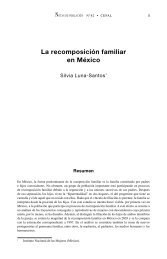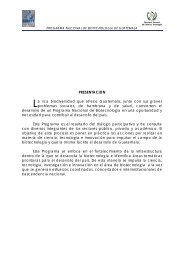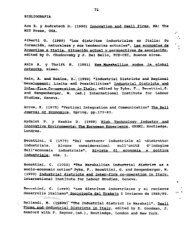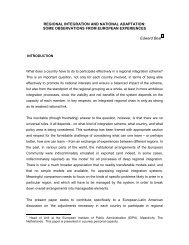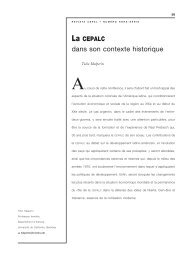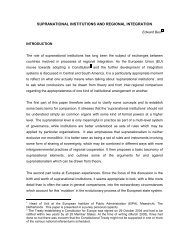revisión de algunos indicadores para medir la desigualdad - Cepal
revisión de algunos indicadores para medir la desigualdad - Cepal
revisión de algunos indicadores para medir la desigualdad - Cepal
You also want an ePaper? Increase the reach of your titles
YUMPU automatically turns print PDFs into web optimized ePapers that Google loves.
REVISIÓN DE ALGUNOS INDICADORES PARA MEDIR<br />
LA DESIGUALDAD<br />
XAVIER MANCERO<br />
CEPAL<br />
375
376 Revisión <strong>de</strong> <strong>algunos</strong> <strong>indicadores</strong> <strong>para</strong> <strong>medir</strong> <strong>de</strong>sigualdad<br />
Medidas <strong>de</strong> Desigualdad<br />
Para <strong>medir</strong> el grado <strong>de</strong> <strong>de</strong>sigualdad en <strong>la</strong><br />
distribución <strong>de</strong>l ingreso, existe una serie <strong>de</strong> índices<br />
disponibles, con propieda<strong>de</strong>s distintas entre sí.<br />
En principio, ninguno <strong>de</strong> ellos es mejor que el<br />
resto. La utilidad <strong>de</strong> cada uno <strong>de</strong>pen<strong>de</strong>rá <strong>de</strong> cómo<br />
satisface <strong>la</strong>s “propieda<strong>de</strong>s <strong>de</strong>seables” <strong>de</strong> los<br />
<strong>indicadores</strong> <strong>de</strong> <strong>de</strong>sigualdad.<br />
Propieda<strong>de</strong>s Deseables<br />
1) In<strong>de</strong>pen<strong>de</strong>ncia <strong>de</strong> esca<strong>la</strong><br />
El indicador no <strong>de</strong>be variar ante transformaciones<br />
proporcionales <strong>de</strong> los ingresos (p.e. unidad <strong>de</strong> medida)<br />
2) In<strong>de</strong>pen<strong>de</strong>ncia <strong>de</strong> tamaño <strong>de</strong> <strong>la</strong> pob<strong>la</strong>ción<br />
La <strong>de</strong>sigualdad <strong>de</strong>be mantenerse si se agrega un número<br />
proporcional <strong>de</strong> individuos a todos los niveles <strong>de</strong> ingreso.<br />
3) In<strong>de</strong>pen<strong>de</strong>ncia ante cambios en posición<br />
Si dos individuos intercambian su posición en <strong>la</strong> distribución<br />
<strong>de</strong> ingresos, <strong>la</strong> <strong>de</strong>sigualdad no <strong>de</strong>be verse afectada.<br />
4) Principio “Débil” <strong>de</strong> Transferencias<br />
La <strong>de</strong>sigualdad <strong>de</strong>be disminuir ante una transferencia <strong>de</strong><br />
ingresos <strong>de</strong> un hogar "rico" a un hogar "pobre”.
Revisión <strong>de</strong> <strong>algunos</strong> <strong>indicadores</strong> <strong>para</strong> <strong>medir</strong> <strong>de</strong>sigualdad 377<br />
Propieda<strong>de</strong>s Deseables<br />
5) Principio “Fuerte” <strong>de</strong> Transferencias<br />
Ante una transferencia <strong>de</strong> ingresos <strong>de</strong> un hogar "rico" a un<br />
hogar "pobre", <strong>la</strong> disminución en <strong>la</strong> <strong>de</strong>sigualdad será más<br />
pronunciada a medida que aumente <strong>la</strong> distancia entre los<br />
ingresos <strong>de</strong> ambos hogares.<br />
6) Descomposición Aditiva<br />
La concentración <strong>de</strong> ingreso <strong>para</strong> una pob<strong>la</strong>ción <strong>de</strong>be ser<br />
igual a <strong>la</strong> suma <strong>de</strong> <strong>la</strong> <strong>de</strong>sigualdad intra-grupal e inter-grupal<br />
<strong>para</strong> los subgrupos que <strong>la</strong> conforman.<br />
7) Rango <strong>de</strong>l Indice<br />
Es <strong>de</strong>seable que el índice tome valores entre 0 y 1, don<strong>de</strong><br />
igualdad máxima = 0 y <strong>de</strong>sigualdad máxima = 1.<br />
Tipos <strong>de</strong> Indicadores <strong>de</strong> Desigualdad<br />
Medidas Estadísticas<br />
– Rango <strong>de</strong> Variación, Desviación Media Re<strong>la</strong>tiva,<br />
Varianza, Coeficiente <strong>de</strong> Variación, Varianza <strong>de</strong> los<br />
Logaritmos.<br />
Curva <strong>de</strong> Lorenz y Coeficiente <strong>de</strong> Gini<br />
Indicadores basados en Funciones <strong>de</strong> Utilidad<br />
Indicadores basados en <strong>la</strong> Entropía
378 Revisión <strong>de</strong> <strong>algunos</strong> <strong>indicadores</strong> <strong>para</strong> <strong>medir</strong> <strong>de</strong>sigualdad<br />
Medidas Estadísticas<br />
Campo <strong>de</strong> Variación<br />
CV<br />
=<br />
y<br />
max<br />
− y<br />
µ<br />
– Indicador poco útil porque sólo <strong>de</strong>pen<strong>de</strong> <strong>de</strong> los valores<br />
extremos <strong>de</strong> <strong>la</strong> distribución.<br />
Desviación Media Re<strong>la</strong>tiva<br />
DMR<br />
n<br />
= ∑<br />
i=<br />
1<br />
– No es sensible a transferencias que ocurren entre<br />
individuos con un ingreso inferior (o superior) a <strong>la</strong><br />
media (no cumple axioma 4).<br />
Varianza<br />
min<br />
( µ )<br />
µ − y n<br />
Medidas Estadísticas<br />
− yi<br />
V = i<br />
n<br />
– Satisface el Axioma <strong>de</strong> Transferencias<br />
– Limitación: Depen<strong>de</strong> <strong>de</strong>l ingreso medio ⇒ Mientras más alto<br />
sea el ingreso, mayor será <strong>la</strong> <strong>de</strong>sigualdad<br />
1<br />
µ<br />
Coeficiente <strong>de</strong> Variación<br />
– Corrige problema <strong>de</strong> <strong>de</strong>pen<strong>de</strong>ncia <strong>de</strong> <strong>la</strong> media.<br />
i<br />
n<br />
∑ =<br />
( )<br />
CV =<br />
– Limitación: El peso <strong>de</strong> <strong>la</strong> transferencia no varía con <strong>la</strong><br />
posición re<strong>la</strong>tiva en <strong>la</strong> distribución (una transferencia <strong>de</strong> $10<br />
tiene el mismo efecto, ya sea <strong>de</strong> $1000 a $900 o <strong>de</strong> $150 a<br />
$50).<br />
2<br />
V<br />
µ
Revisión <strong>de</strong> <strong>algunos</strong> <strong>indicadores</strong> <strong>para</strong> <strong>medir</strong> <strong>de</strong>sigualdad 379<br />
Medidas Estadísticas<br />
Varianza <strong>de</strong> los Logaritmos<br />
VL<br />
n<br />
∑<br />
i=<br />
= 1<br />
( log µ − log y )<br />
– Respecto a <strong>la</strong> Varianza, <strong>la</strong> utilización <strong>de</strong> logaritmos permite<br />
asignar más peso a <strong>la</strong>s transferencias que se <strong>de</strong>n en <strong>la</strong> parte<br />
baja <strong>de</strong> <strong>la</strong> distribución.<br />
– El resultado no varía con el ingreso medio.<br />
Curva <strong>de</strong> Lorenz<br />
Muestra el porcentaje acumu<strong>la</strong>tivo <strong>de</strong> ingreso que<br />
poseen los individuos u hogares, or<strong>de</strong>nados en forma<br />
ascen<strong>de</strong>nte <strong>de</strong> acuerdo con su nivel <strong>de</strong> ingreso.<br />
100%<br />
% acumu<strong>la</strong>do<br />
ingresos<br />
45°<br />
0 % acumu<strong>la</strong>do<br />
pob<strong>la</strong>ción<br />
100%<br />
n<br />
i<br />
2<br />
Línea <strong>de</strong><br />
Equidistribución<br />
Curva <strong>de</strong> Lorenz
380 Revisión <strong>de</strong> <strong>algunos</strong> <strong>indicadores</strong> <strong>para</strong> <strong>medir</strong> <strong>de</strong>sigualdad<br />
Curva <strong>de</strong> Lorenz<br />
Para <strong>de</strong>terminar el grado <strong>de</strong> <strong>de</strong>sigualdad, se com<strong>para</strong><br />
<strong>la</strong>s Curvas <strong>de</strong> Lorenz.<br />
A “domina” a B ⇒ Desigualdad<br />
es menor en A<br />
A<br />
B<br />
A y B se cruzan ⇒ No es posible<br />
establecer com<strong>para</strong>ciones<br />
Curva <strong>de</strong> Lorenz Generalizada<br />
En caso <strong>de</strong> que <strong>la</strong>s Curvas <strong>de</strong> Lorenz se crucen, es<br />
posible utilizar <strong>la</strong> CL Generalizada, multiplicando los<br />
valores por <strong>la</strong> media <strong>de</strong> cada distribución (µ A y µ B).<br />
µ A<br />
µ B<br />
0 100%<br />
A<br />
B<br />
A<br />
B
Revisión <strong>de</strong> <strong>algunos</strong> <strong>indicadores</strong> <strong>para</strong> <strong>medir</strong> <strong>de</strong>sigualdad 381<br />
Com<strong>para</strong>ciones <strong>de</strong> Bienestar con <strong>la</strong><br />
Curva <strong>de</strong> Lorenz<br />
El “bienestar” no <strong>de</strong>pen<strong>de</strong> únicamente <strong>de</strong> <strong>la</strong><br />
distribución, sino también <strong>de</strong> otros factores como el<br />
nivel <strong>de</strong> ingresos.<br />
– A y B son distribuciones acumu<strong>la</strong>das <strong>de</strong>l ingreso.<br />
–Si L A “domina” a L B y µ A ≥ µ B ⇒ bienestar es mayor en A<br />
–Si L A “domina” a L B y µ B > µ A ⇒ se com<strong>para</strong> LG<br />
–Si L A y L B se cruzan pero LG A y LG B no ⇒ se com<strong>para</strong> LG<br />
–Si LGA y LGB se cruzan ⇒ no es posible realizar<br />
com<strong>para</strong>ciones <strong>de</strong> bienestar<br />
Coeficiente <strong>de</strong> Gini<br />
Indica el área comprendida entre <strong>la</strong> Curva <strong>de</strong> Lorenz y<br />
<strong>la</strong> Línea <strong>de</strong> Equidistribución, expresada como un<br />
porcentaje <strong>de</strong>l área total.<br />
M<br />
N<br />
Gini = M / (M + N)<br />
G ∈ [0,1]<br />
Existen diversas fórmu<strong>la</strong>s que se aproximan al valor <strong>de</strong>l<br />
Coeficiente <strong>de</strong> Gini.
382 Revisión <strong>de</strong> <strong>algunos</strong> <strong>indicadores</strong> <strong>para</strong> <strong>medir</strong> <strong>de</strong>sigualdad<br />
Coeficiente <strong>de</strong> Gini<br />
Si bien el Coeficiente <strong>de</strong> Gini es el indicador <strong>de</strong><br />
<strong>de</strong>sigualdad más utilizado (por su facilidad <strong>de</strong><br />
interpretación), presenta <strong>algunos</strong> problemas:<br />
– Es insensible ante cambios en <strong>la</strong> distribución el ingreso que<br />
mantengan inalterada el área bajo <strong>la</strong> línea <strong>de</strong> 45°.<br />
– No cumple con el axioma “fuerte” <strong>de</strong> transferencias; es <strong>de</strong>cir,<br />
<strong>la</strong>s transferencias no se pon<strong>de</strong>ran por su posición en <strong>la</strong> esca<strong>la</strong><br />
<strong>de</strong> ingresos.<br />
– Su interpretación pue<strong>de</strong> dar resultados ambiguos cuando <strong>la</strong>s<br />
Curvas <strong>de</strong> Lorenz se cruzan.<br />
– No satisface <strong>la</strong> propiedad <strong>de</strong> <strong>de</strong>scomposición aditiva; es <strong>de</strong>cir,<br />
<strong>la</strong> <strong>de</strong>sigualdad en un país no se pue<strong>de</strong> obtener a partir <strong>de</strong> los<br />
coeficientes <strong>de</strong> Gini <strong>para</strong> cada región.<br />
Indicadores basados en Funciones <strong>de</strong><br />
Utilidad<br />
Todos los <strong>indicadores</strong> <strong>de</strong> bienestar tienen una función<br />
<strong>de</strong> bienestar implícita. Existen índices que p<strong>la</strong>ntean<br />
explícitamente <strong>la</strong> función <strong>de</strong> utilidad a utilizar.<br />
El primer índice <strong>de</strong> este tipo fue <strong>de</strong>l Indice <strong>de</strong> Dalton:<br />
D = 1−<br />
n<br />
∑ i=<br />
1<br />
U<br />
nU<br />
( yi<br />
)<br />
( µ<br />
)<br />
– Este índice muestra <strong>la</strong> “pérdida” <strong>de</strong> bienestar <strong>de</strong>bida a <strong>la</strong><br />
<strong>de</strong>sigualdad con respecto a una distribución igualitaria.<br />
– Su limitación principal es que varía con <strong>la</strong>s transformaciones<br />
a <strong>la</strong> función U(.), por lo que tiene poca utilidad práctica.
Revisión <strong>de</strong> <strong>algunos</strong> <strong>indicadores</strong> <strong>para</strong> <strong>medir</strong> <strong>de</strong>sigualdad 383<br />
Indicadores basados en Funciones <strong>de</strong><br />
Utilidad<br />
Un indicador que corrige este <strong>de</strong>fecto es el Indice <strong>de</strong><br />
Atkinson, basado en <strong>la</strong> noción <strong>de</strong>l “ingreso<br />
igualitariamente distribuido” (y e ):<br />
ye<br />
A −<br />
µ<br />
=1 A ∈ [0,1]<br />
–ye es el ingreso que, si se distribuyera equitativamente,<br />
proporcionaría el mismo nivel <strong>de</strong> utilidad que <strong>la</strong> distribución<br />
actual.<br />
– Interpretación <strong>de</strong>l Indice: Si A = 0.3 ⇒ se necesitaría el 70%<br />
<strong>de</strong>l nivel <strong>de</strong> ingresos <strong>para</strong> alcanzar el mismo nivel <strong>de</strong> utilidad<br />
actual.<br />
Indicadores basados en Funciones <strong>de</strong><br />
Utilidad<br />
En <strong>la</strong> práctica, el cálculo <strong>de</strong>l Indice <strong>de</strong> Atkinson<br />
requiere <strong>de</strong>finir una función <strong>de</strong> Utilidad. Se suele<br />
utilizar <strong>la</strong> siguiente:<br />
1−ε<br />
y<br />
U<br />
( y)<br />
=<br />
1−<br />
ε<br />
– El parámetro ε representa <strong>la</strong> “aversión a <strong>la</strong> <strong>de</strong>sigualdad”<br />
(característica práctica <strong>de</strong>l índice <strong>de</strong> Atkinson):<br />
ε = 0 implica indiferencia ante <strong>la</strong> <strong>de</strong>sigualdad;<br />
a medida que ε → ∞, aumenta <strong>la</strong> importancia <strong>de</strong> los más<br />
pobres.
384 Revisión <strong>de</strong> <strong>algunos</strong> <strong>indicadores</strong> <strong>para</strong> <strong>medir</strong> <strong>de</strong>sigualdad<br />
Indicadores basados en <strong>la</strong> Entropía<br />
Existen <strong>indicadores</strong> que aprovechan <strong>la</strong> noción <strong>de</strong><br />
“contenido informativo”: a menor probabilidad <strong>de</strong><br />
ocurrencia <strong>de</strong> un evento, mayor información contiene<br />
su realización.<br />
Aplicando este concepto a <strong>la</strong> distribución <strong>de</strong> ingresos,<br />
se obtiene un indicador que asigna mayor importancia a<br />
los ingresos más bajos.<br />
El indicador más conocido <strong>de</strong> este tipo es el Indice <strong>de</strong><br />
Theil:<br />
n<br />
1 ⎛ Yi<br />
⎞<br />
T = ∑ Yi<br />
log⎜<br />
⎟<br />
nµ<br />
i=<br />
1 ⎝ µ ⎠<br />
Indicadores basados en <strong>la</strong> Entropía<br />
Las mayores ventajas <strong>de</strong>l Indice <strong>de</strong> Theil son:<br />
– Cumple con el Axioma <strong>de</strong> Descomposición Aditiva<br />
– Cumple con el Axioma “Fuerte” <strong>de</strong> Transferencias<br />
Una posible limitación sería <strong>la</strong> arbitrariedad <strong>de</strong> aplicar<br />
una forma logarítmica, ya que <strong>la</strong> utilización <strong>de</strong> otras<br />
también es factible.
Revisión <strong>de</strong> <strong>algunos</strong> <strong>indicadores</strong> <strong>para</strong> <strong>medir</strong> <strong>de</strong>sigualdad 385<br />
Otros Indicadores<br />
Indice Generalizado <strong>de</strong> Entropía:<br />
I<br />
β<br />
1<br />
=<br />
β + 1<br />
∫<br />
⎡⎛<br />
y ⎞<br />
⎢⎜<br />
⎟<br />
⎢⎣<br />
⎝ µ ⎠<br />
β + 1<br />
⎤<br />
−1⎥<br />
dF ( y)<br />
⎥⎦<br />
Adicionalmente, existe una vasta lista <strong>de</strong> <strong>indicadores</strong> <strong>de</strong><br />
<strong>de</strong>sigualdad.<br />
Conclusiones<br />
Para <strong>medir</strong> <strong>la</strong> <strong>de</strong>sigualdad, existe una vasta serie <strong>de</strong><br />
<strong>indicadores</strong> con distintas propieda<strong>de</strong>s.<br />
Los valores <strong>de</strong> estos <strong>indicadores</strong> no son directamente<br />
com<strong>para</strong>bles entre sí, y es probable que generen<br />
or<strong>de</strong>namientos distintos <strong>para</strong> <strong>la</strong>s distribuciones <strong>de</strong><br />
ingreso.<br />
Para consi<strong>de</strong>rar que una distribución es más <strong>de</strong>sigual<br />
que otra, todos los <strong>indicadores</strong> <strong>de</strong>ben coincidir, <strong>de</strong> otra<br />
forma el resultado es ambiguo.
386 Revisión <strong>de</strong> <strong>algunos</strong> <strong>indicadores</strong> <strong>para</strong> <strong>medir</strong> <strong>de</strong>sigualdad<br />
Conclusiones<br />
Ningún indicador es estrictamente superior, por lo<br />
tanto, es conveniente utilizar varios <strong>indicadores</strong> a<br />
<strong>la</strong> vez, <strong>de</strong> manera complementaria.<br />
A pesar <strong>de</strong> ser extensamente utilizado, el Indice <strong>de</strong><br />
Gini tiene algunas características que limitan su<br />
utilidad:<br />
– No satisface Axioma “Fuerte” <strong>de</strong> Transferencias<br />
– No satisface <strong>de</strong>scomposición aditiva<br />
– No es c<strong>la</strong>ro cuando Curvas <strong>de</strong> Lorenz se cruzan<br />
– Peso <strong>de</strong> transferencias es mayor en torno al centro <strong>de</strong> <strong>la</strong><br />
distribución.






